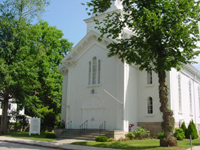
|
|
 |
|
-------------------------------------------------------------------------- This two manual instrument has 25 stops, 28 ranks of pipes and 1531 pipes. It also has a zimbelstern, a small set of rotating bells which lend a festive air on special occasions. The Pedal and Great divisions of the organ are on the left, as one faces the balcony. The Swell is enclosed in a box on the right, behind movable shutters which allow the volume of the sound to be varied by an expression pedal on the console. The 33 pipes of the facade are part of the principal 16' and 8' ranks of the pedal and great organ, respectively. They are all speaking pipes, and are composed of an alloy of high tin content which has been painstakingly burnished to a bright sheen--the first Austin organ to have such burnished pipes. Behind the grille cloth are 1,498 more pipes, the largest of which are more than 8' in length and are made of zinc or wood. Because of the limited ceiling height in the balcony, the largest pipes are mounted on their sides, which in no way detracts from their sound. The smallest pipes are about 1 inch long and the diameter of a pencil. Most of the pipes are composed of a mixture of tin and lead called "spotted metal." All were made individually by hand with processes and tools that have changed little in many centuries. The organ has low wind pressure and classic voicing, which gives it the clarity and tonal beauty of the 17th and 18th century organs. The tonal design and flexibility permit the music of all eras to be played. |